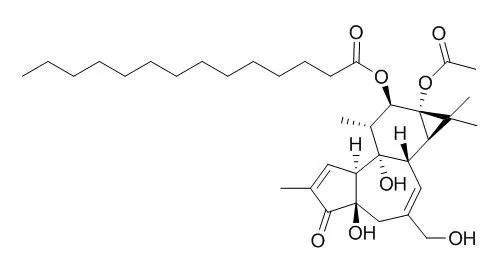| In vivo: |
| J Pharm Pharmacol. 2013 Aug;65(8):1223-30. | | Structure-dependent inhibitory effects of synthetic cannabinoids against 12-O-tetradecanoylphorbol-13-acetate-induced inflammation and skin tumour promotion in mice.[Pubmed: 23837590] |
METHODS AND RESULTS:
Twenty-three analogues of synthetic cannabinoids were isolated from, and identified as adulterants in, illegal drugs distributed in the Tokyo metropolitan area, and were examined for their inhibitory effects on the induction of oedema in mouse ears by 12-O-tetradecanoylphorbol-13-acetate (TPA). Furthermore, selected cannabinoids, JWH-018, -122 and -210, were studied for their effects on carcinogenesis induced in mouse skin initiated with 7,12-dimethylbenz[a]anthracene (DMBA) and promoted by 12-O-tetradecanoylphorbol-13-acetate. Among cannabinoids, naphthoylindoles mostly exhibited superior inhibitory effects against 12-O-tetradecanoylphorbol-13-acetate-induced ear oedema and, especially, JWH-018, -122 and -210 showed potent activity with 50% inhibitory dose (ID50) values of 168, 346 and 542 nm, respectively (an activity corresponding to that of indometacin (ID50 = 908 nm)). Furthermore these three compounds also markedly suppressed the tumour-promoting activity of 12-O-tetradecanoylphorbol-13-acetate.
CONCLUSIONS:
This is the first report indicating the structure-activity relationships for the anti-inflammatory activity of synthetic cannabinoids on 12-O-tetradecanoylphorbol-13-acetate-induced inflammation in mice. Naphthoylindoles, JWH-018, -122 and -210, had the most potent anti-inflammatory activity and also markedly inhibited tumour promotion by 12-O-tetradecanoylphorbol-13-acetate in the two-stage mouse skin carcinogenesis model. The present results suggest that synthetic cannabinoids, such as JWH-018, -122 and -210, may be used as cancer chemopreventive agents in the future. | | Vet Pathol. 2013 Sep;50(5):903-8. | | Tumor promotion by 12-O-tetradecanoylphorbol-13-acetate in an ultra-short-term skin carcinogenesis bioassay using rasH2 mice.[Pubmed: 23610217] |
METHODS AND RESULTS:
Assessment of the skin tumor-promoting potential of 12-O-tetradecanoylphorbol-13-acetate (TPA) after initiation with 7,12-dimethylbenz[a]anthracene (DMBA) was conducted using rasH2 transgenic (Tg) mice and their nontransgenic (non-Tg) littermates. Mice were treated with DMBA (50 μg/100 μL acetone) on clipped back skin at the commencement of the study, and 1 week thereafter, 12-O-tetradecanoylphorbol-13-acetate was applied at 8 μg/200 μL or 4 μg/200 μL acetone, once or twice weekly, for 7 weeks.In conclusion, skin promotion effects could be detected within only 8 weeks in the rasH2 mice, and the concentration of 4 μg 12-O-tetradecanoylphorbol-13-acetate once weekly was sufficient as a positive control.
CONCLUSIONS:
This short-term skin carcinogenesis bioassay using rasH2 mice could represent a useful tool for the assessment of drug and chemical safety with cutaneous treatment. |
|






 Cell. 2018 Jan 11;172(1-2):249-261.e12. doi: 10.1016/j.cell.2017.12.019.IF=36.216(2019)
Cell. 2018 Jan 11;172(1-2):249-261.e12. doi: 10.1016/j.cell.2017.12.019.IF=36.216(2019) Cell Metab. 2020 Mar 3;31(3):534-548.e5. doi: 10.1016/j.cmet.2020.01.002.IF=22.415(2019)
Cell Metab. 2020 Mar 3;31(3):534-548.e5. doi: 10.1016/j.cmet.2020.01.002.IF=22.415(2019) Mol Cell. 2017 Nov 16;68(4):673-685.e6. doi: 10.1016/j.molcel.2017.10.022.IF=14.548(2019)
Mol Cell. 2017 Nov 16;68(4):673-685.e6. doi: 10.1016/j.molcel.2017.10.022.IF=14.548(2019)